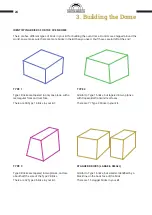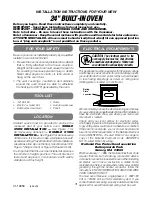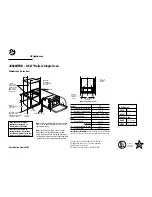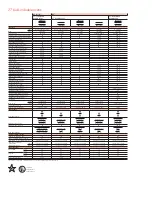
10
Safe Installation Instructions
DUST EXPOSURE – RESPIRABLE CRYSTALLINE SILICA
Inhalation of airborne dust may cause irritation to the mucous membrane and upper airways. Symptoms can include coughing, sneezing
and breathing difficulties. Repeated exposure to respirable silica may result in pulmonary fibrosis (silicosis). Silicosis is a fibronodular lung
disease caused by deposition in the lungs of fine respirable particles of crystalline silica. Principal symptoms of silicosis are coughing
and breathlessness.
The following materials in your Wood Fired Oven Kit may contain respirable crystalline silica and a suitable dust mask should be worn
while handling them;
•
Hybrid Refractory Bedding Mortar (marked Airset Mortar)
•
Refractory Mortar Part A
•
Refractory Mortar Part B
•
Refractory Castable
•
Fire bricks (when cutting or shaping them with a grinder)
• Perlite
•
Calcium Silicate Board
While the Ceramic Fibre Blanket does not contain respirable silica, the fibers are very irritating to the respiratory tract and can cause
irritation in the nose and throat, and chest discomfort. A suitable dust mask should be worn when working with the ceramic fibre blanket,
until the first layer of Perlite Render has been applied to seal the ceramic fibre blanket from the atmosphere.
EYE PROTECTION
This is a very hands-on project and you are advised to wear safety glasses when mixing any of the materials or cutting/grinding bricks.
This also applies to applying the ceramic fibre blanket insulation, which is irritating to the eyes. If in doubt, wear safety glasses!
SKIN PROTECTION
The mortar mixture that you’ll use to lay the fire bricks in your Wood Fired Oven Kit is quite alkaline, and repeated exposure to your skin can
result in chemical burns. The same goes for the Refractory Castable and Perlite Render mixes. This is compounded by having to handle
wet bricks, which (if done without gloves) makes your skin softer and more vulnerable to being attacked by these materials.
IGNORE THIS
AT YOUR OWN RISK! THE AUTHOR HAS PERMANENT SCARRING TO REMIND HIM OF THE IMPORTANCE OF WEARING GLOVES�
To avoid this, wear rubber ‘washing up’ gloves underneath ordinary gardening gloves to protect your skin. Rubber gloves alone may not
work well for long, as handling the fire bricks can wear straight through them very quickly. There are some heavy duty rubber gloves
available at some supermarkers and hardware stores that work very well by themselves, as you will see in the instructional videos.
The key is to keep your hands dry, and if you notice a hole in the rubber gloves you would be well advised to replace them immediately.
Avoid rubber gloves with an elastic cuff at the wrist – these can rub your skin and leave it exposed to attack from the alkaline material
you’re handling. If your hands get wet inside the gloves, remove the gloves, dry your hands and put on a new pair of gloves, turning the
others inside out to dry so they can be used later. For this reason it’s worth having two pairs of rubber gloves.
The Ceramic Fibre Blanket can be irritating to the skin, with some people experiencing rash symptoms, so we have provided you with two
large plastic gloves that loop over your neck and cover the length of your arms. Wear these when handling the Ceramic Fibre Blanket.
Summary of Contents for D95
Page 1: ...D95 Brick Oven D95 PRECUT BRICK OVEN KIT Instruction Booklet ...
Page 44: ...44 Examples ...
Page 45: ...45 Examples ...











































